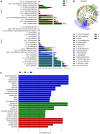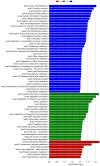Altered oral microbiota in chronic hepatitis B patients with different tongue coatings
- PMID: 30122883
- PMCID: PMC6092577
- DOI: 10.3748/wjg.v24.i30.3448
Altered oral microbiota in chronic hepatitis B patients with different tongue coatings
Abstract
Aim: To elucidate tongue coating microbiota and metabolic differences in chronic hepatitis B (CHB) patients with yellow or white tongue coatings.
Methods: Tongue coating samples were collected from 53 CHB patients (28 CHB yellow tongue coating patients and 25 CHB white tongue coating patients) and 22 healthy controls. Microbial DNA was extracted from the tongue samples, and the bacterial 16S ribosomal RNA gene V3 region was amplified from all samples and sequenced with the Ion Torrent PGM™ sequencing platform according to the standard protocols. The metabolites in the tongue coatings were evaluated using a liquid chromatography-mass spectrometry (LC-MS) platform. Statistical analyses were then performed.
Results: The relative compositions of the tongue coating microbiotas and metabolites in the CHB patients were significantly different from those of the healthy controls, but the tongue coating microbiota abundances and diversity levels were not significantly different. Compared with the CHB white tongue coating patients, the CHB yellow tongue coating patients had higher hepatitis B viral DNA (HBV-DNA) titers (median 21210 vs 500, respectively, P = 0.03) and a significantly lower level of Bacteroidetes (20.14% vs 27.93%, respectively, P = 0.013) and higher level of Proteobacteria (25.99% vs 18.17%, respectively, P = 0.045) in the microbial compositions at the phylum level. The inferred metagenomic pathways enriched in the CHB yellow tongue coating patients were mainly those involved in amino acid metabolism, which was consistent with the metabolic disorder. The abundances of bacteria from Bacteroidales at the order level were higher in the CHB white tongue coating patients (19.2% vs 27.22%, respectively, P = 0.011), whereas Neisseriales were enriched in the yellow tongue coating patients (21.85% vs 13.83%, respectively, P = 0.029). At the family level, the abundance of Neisseriaceae in the yellow tongue patients was positively correlated with the HBV-DNA level but negatively correlated with the S-adenosyl-L-methionine level.
Conclusion: This research illustrates specific clinical features and bacterial structures in CHB patients with different tongue coatings, which facilitates understanding of the traditional tongue diagnosis.
Keywords: 16S rRNA gene sequencing; Chronic hepatitis B; Metabolomics; Microbiota; Tongue diagnosis.
Conflict of interest statement
Conflict-of-interest statement: There are no conflicts of interest to report.
Figures





Similar articles
-
Microbial biomarkers of common tongue coatings in patients with gastric cancer.Microb Pathog. 2019 Feb;127:97-105. doi: 10.1016/j.micpath.2018.11.051. Epub 2018 Nov 30. Microb Pathog. 2019. PMID: 30508628
-
Gut microbiota dysbiosis in patients with hepatitis B virus-induced chronic liver disease covering chronic hepatitis, liver cirrhosis and hepatocellular carcinoma.J Viral Hepat. 2020 Feb;27(2):143-155. doi: 10.1111/jvh.13216. Epub 2019 Oct 29. J Viral Hepat. 2020. PMID: 31600845
-
Microbiological characteristics of different tongue coatings in adults.BMC Microbiol. 2022 Sep 9;22(1):214. doi: 10.1186/s12866-022-02626-7. BMC Microbiol. 2022. PMID: 36085010 Free PMC article.
-
Hepatitis B virus DNA and hepatitis B surface antigen levels in chronic hepatitis B.Expert Rev Anti Infect Ther. 2010 Jun;8(6):717-26. doi: 10.1586/eri.10.45. Expert Rev Anti Infect Ther. 2010. PMID: 20521898 Review.
-
The role of gut microbiota in hepatitis B disease progression and treatment.J Viral Hepat. 2022 Feb;29(2):94-106. doi: 10.1111/jvh.13595. Epub 2021 Aug 30. J Viral Hepat. 2022. PMID: 34415656 Review.
Cited by
-
The Commensal Microbiota and Viral Infection: A Comprehensive Review.Front Immunol. 2019 Jul 4;10:1551. doi: 10.3389/fimmu.2019.01551. eCollection 2019. Front Immunol. 2019. PMID: 31333675 Free PMC article.
-
Microbial community structure of different tongue fur types in patients with chronic gastritis.J Tradit Chin Med. 2023 Apr;43(2):365-373. doi: 10.19852/j.cnki.jtcm.20221206.003. J Tradit Chin Med. 2023. PMID: 36994526 Free PMC article.
-
Oral microbiome and pancreatic cancer.World J Gastroenterol. 2020 Dec 28;26(48):7679-7692. doi: 10.3748/wjg.v26.i48.7679. World J Gastroenterol. 2020. PMID: 33505144 Free PMC article.
-
Microbiota and viral hepatitis: State of the art of a complex matter.World J Gastroenterol. 2021 Sep 7;27(33):5488-5501. doi: 10.3748/wjg.v27.i33.5488. World J Gastroenterol. 2021. PMID: 34588747 Free PMC article. Review.
-
Development of a tongue image-based machine learning tool for the diagnosis of gastric cancer: a prospective multicentre clinical cohort study.EClinicalMedicine. 2023 Feb 6;57:101834. doi: 10.1016/j.eclinm.2023.101834. eCollection 2023 Mar. EClinicalMedicine. 2023. PMID: 36825238 Free PMC article.
References
-
- Lira-Junior R, Boström EA. Oral-gut connection: one step closer to an integrated view of the gastrointestinal tract? Mucosal Immunol. 2018;11:316–318. - PubMed
Publication types
MeSH terms
Substances
LinkOut - more resources
Full Text Sources
Other Literature Sources

